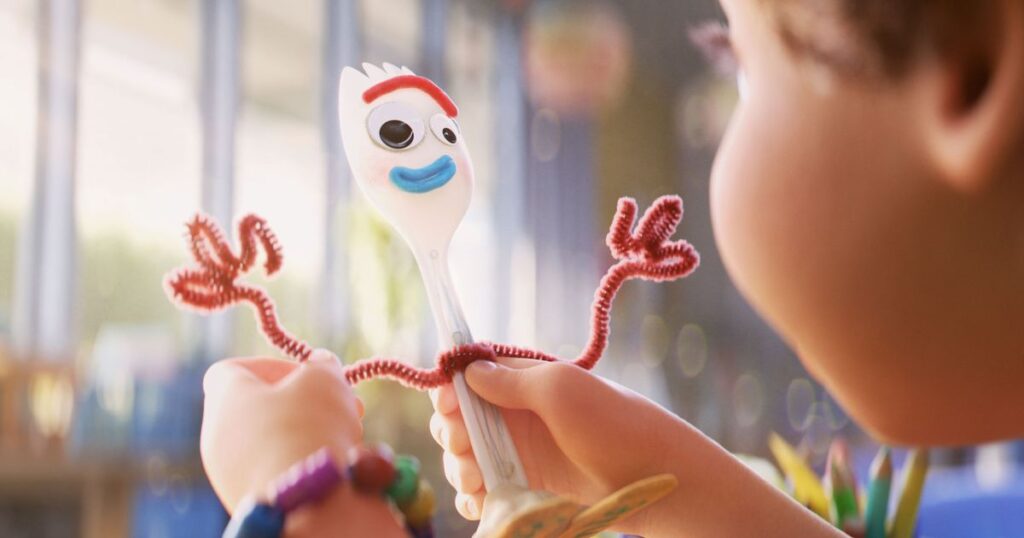The new episode of Toy Story introduces us to Forky, a seemingly worthless kid’s toy made from materials most of us would regard as trash. However, for marketers, Forky’s story and the development of his character is an object lesson in creating buyer personas.
Let’s start with the obvious. If you haven’t watched Toy Story 4 yet, stop reading and go see it.
It’s a tough sell to get people to watch sequels, especially the fourth installment in a series made for kids. However, TS4 is quite possibly the funniest animated movie to come out in quite some time thanks to the pitiful and incredibly relatable Forky.
Who is Forky?
The main human child in the movie, Bonnie, struggles with anxiety, nervousness and loneliness during kindergarten orientation. Using a hodge-podge mix of craft materials, she creates a figurine, named Forky, to keep her company using a spork, pipe cleaners, and popsicle sticks.
The concept of Forky is all too familiar with parents whose kids come home everyday from school with a wide variety of junky objects. The intent of these “toys” is temporary. Keep the kids entertained during the day doing something fun within the limits of their motor skills and creative capabilities.
By becoming a toy, Forky is animated for a higher purpose: make the child happy.
The audience is treated to a character that is instantly endearing. He’s cute. He’s imperfect. He struggles with the existential crisis of being crafted from single-use materials. He carries the burden of having to be a toy without the luxury of being manufactured to perform like one. Forky’s sole desire is to go where he belongs: in the dumpster.
In what is quite possibly the funniest line of the movie, Woody introduces him by his name Forky, to which Forky replies, “I’M TRASH”.
Aren’t we all, Forky?
How Forky Extends the Pixar Brand
The story of how Forky was developed is simple enough. The Pixar team was talking about toys and the frustration all parents experience when your kids ignore the toys you buy for them in favor of the box they came in. The Pixar team fully invested themselves in the story of this fragile character once they settled on him being a spork – which in its own right is the laughing stock of the plastic utensil world.
Pixar doesn’t take chances with the Toy Story franchise. It was their first feature film, and it is one of the most critically-acclaimed animated movies in history. To put it simply, if there was no Toy Story, there most likely would be no Pixar as we know it today. Tarnishing the Toy Story brand in turn sullies the value of Pixar.
They never set out just to tell a cute story. The subplots in their movies are metaphors for our own lives, and each character must be relatable to the extent that the viewer passionately identifies with them. In many ways they face the same challenges we do every day. Their achievements inspire us. When they win, we win.
Forky is unique. He takes us where no other animated character has been. He’s neurotic. He’s anxious. He has a complex. He’s imperfect. He struggles to perform. He falls apart. He’s innocent and gullible. He asks the philosophical questions we all ask ourselves. “Why am I alive?”
In short, Forky is all of us.
How Does Forky Relate to Marketing?
As stated above, Pixar takes their brand very seriously. They also understand their audience really well. It’s not enough to say their movies appeal to “kids”. It goes well beyond that.
Who makes the ultimate decision to take kids to the movies and buy them merchandise? Parents. And in that regard, Pixar focuses on an experience that adults can also appreciate.
Every Pixar movie is unique, and it could be argued that every movie has its own audience. While Toy Story tells a story that resonates with a wide variety of viewers, other titles like Brave, Coco, and WALL-E do not. Nevertheless, Pixar strives to explore themes and develop creative details that will connect with the emotions and motivations of each viewer hooked by the original storylines of the characters.
This product segmentation allows Pixar to broaden their brand to more viewers, thereby expanding market share. By differentiating their movies along unique interests for different target audiences, they end up bringing more viewers to their flagship products with universal appeal, like Toy Story, and the characters that represent all of us, like Forky.
In marketing terms, knowing your audience and making products that speak directly to them increases the odds they’ll buy other products from you that are meant for the general population. In order to do that, you must understand the specific features and benefits of your products that meet the needs for each of these sub-audiences. That knowledge comes from creating buyer personas.
Knowing Your Audience Means Knowing What Moves Them
Buyer Personas, otherwise known as Customer Personas, are semi-fictional representations of the buyers for which each product is developed. It encompasses all of the personal motivations that inspires them to buy.
Creating buyer personas quite literally means writing up an archetype of that buyer. Who are they? What is their place in life? What do they do? What do they want? More importantly, what do they need, and what benefits will your product provide for them?
Creating buyer personas allows you, the marketer, to learn how to tell your brand story in a way that resonates with them on an emotional level. By understanding your buyer, you master the ability to position your product or service in a way that introduces it with the most impact. Additionally, you discover how to align your entire organization so that it brings that buyer (and many others) to invest in more products or services within your brand.
While it’s unknown by us if Pixar goes through the prerequisite of creating buyer personas, they certainly invest the time and energy to carefully explore how their movies and characters appeal to different viewers. Every detail must be authentic. Every running gag must connect with the comedic and cultural sensibilities of the viewer. Every setting has to conform within the premise of the storyline.
This deep creative process also gives them the insight they need to develop characters that represent all of us, like Forky.
Forky Is a Marketer’s Dream
Forky’s struggles are similar to all of ours in this modern world. Anxious? Check. Confused? You bet. Struggling to find our true calling? Absolutely. Pixar skillfully took the irony of the “trash as toy” concept and applied it to what they know about their viewers across every target segment.
Like Toy Story, The Incredibles, and Monsters Inc, the three flagships of the Pixar brand, Forky’s story connects all of us together through the emotion of feeling lost in this world, thrust into it against our will, compelled by a higher calling we didn’t really ask for…. And seeming not quite sure we’re designed to succeed.
Forky is such a sensation that an entirely new line of merchandise has emerged from our neurotic little friend. Let’s not forget, Forky is a spork with popsicle legs and wire cleaner arms. He’s a toy made by a 5-year-old using the scraps of the craft bin. And yet, most ironically, you can buy your very own Forky toy online for about $20.
How’s that for powerful marketing?

